Your employee Net Promoter Score (eNPS): the what, why, and how

Tapping into staff sentiment and gauging our employee engagement levels is critical in today’s competitive business environment. But what’s actually involved? And more importantly, how can we improve how our staff feel?
What do our employees think about us as an organization? How do they feel? What’s working, and what isn’t? How can we improve?
We now understand more than ever the importance of employee engagement and its impact on business performance.
Historically, success was measured externally: through customer feedback, for example, or reviews and testimonials. But in today’s crowded marketplace, employee experience and customer experience are intrinsically linked.
Our people have become our main differentiator and source of competitive advantage; and as such, we need to look internally and evaluate what our staff thinks in order to stay ahead.
Staff surveys, evaluations, and forums are far from new. However, they can demand a lot of resource, effort, and time – only to inevitably see a 10% participation rate or occur just once a year and give us information far too late for any action to be taken.
If the best employers continually listen to their employees and act on what they learn, how do we overcome those challenges? Is there a simple way to measure the pulse of our organization on a more timely, regular basis?
Yes: introducing the employee Net Promoter Score (eNPS).
7 useful tips for retaining your employees
What is an employee Net Promoter Score (eNPS)?
If you’re new to the concept of eNPS, it’s worth breaking it down and understanding how it’s used, and what it means. If you’re familiar with the ‘what’ already, skip right on to the how and why!
The eNPS definition is a scoring system designed to help employers measure employee engagement, satisfaction, and loyalty. It’s based on the Net Promoter Score, a customer service tool developed by Bain & Company, Satmetrix Systems, Inc., and Fred Reichheld.
The main appeal of the eNPS is that it is wonderfully simple: consisting of just two questions, which give you a great starting point to understand how your employees feel about their place of work.
The first question asks, on a scale of 1 – 10, how likely is it that the staff member would recommend your organization as a place to work. This is followed by an open question, asking the staff member why they chose the rating they did.
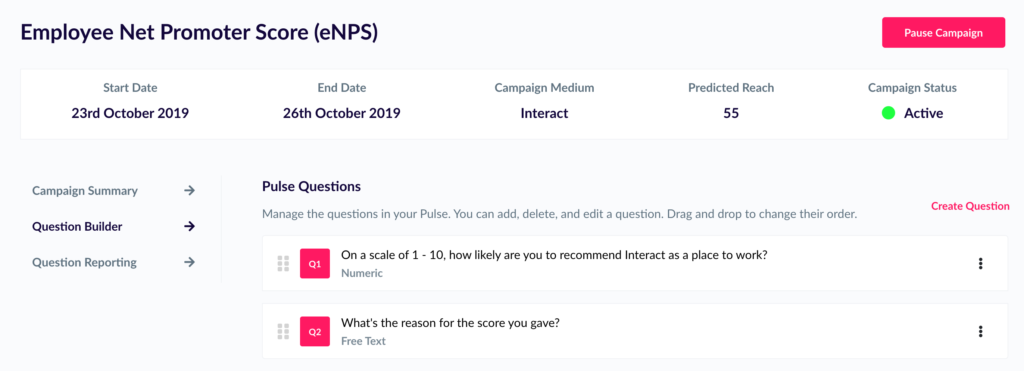
Those who vote 9 or 10 are classed as ‘promoters’; 7 or 8 are ‘passives’, or ‘neutrals’; and 6 or below are ‘detractors’. To determine the net score, employers take the total % of detractors away from the % of promoters. Those who gave a ‘neutral’ score aren’t counted.
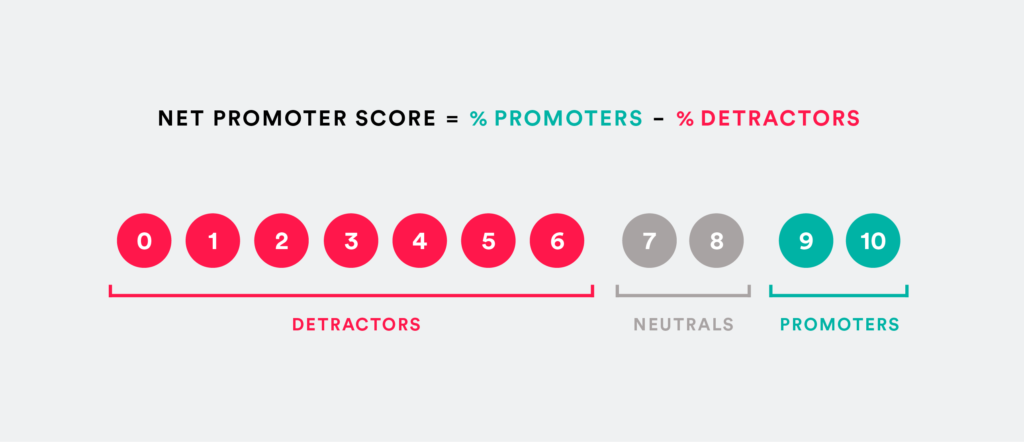
The final number is your employee Net Promoter Score, or eNPS.
For example, if you have 1000 employees and the results are:
- 300 detractors
- 450 neutrals
- 250 promoters
25% (Promoters) – 30% (Detractors) = -17.5%. As the score is represented as a number rather than a percentage, the final eNPS is -17.5.
Why do I need to measure my employee Net Promoter Score (eNPS) ?

We mentioned in the introduction just how important employee engagement has become as a performance benchmark for today’s organizations. However, the true value of conducting an eNPS goes even further than this.
Conducting an eNPS survey shows your employees that their opinion and voice matters to your organization.
At a top-level, your score is a good indication of:
- Loyalty
- Satisfaction
- Engagement
- Churn risk/retention
- Employer brand
- Morale
These, in turn, feed into the sense of attachment and degree of discretionary effort your staff will put into their roles. Measuring and improving your eNPS will, therefore, impact on other key business metrics including:
- Productivity and output
- Customer experience and satisfaction
- Profitability
- Innovation and creativity
…and more.
Promoters, for example, are more likely to advocate for your organization publicly, helping you to attract both customers and prospective talent. They’re more likely to stay with your organization, reducing staff attrition which can prove hugely costly to your business.
At the opposite end of the scale, detractors may be negative about your organization, disengaged, unproductive, lacking in morale, and costly to the business.
Ultimately, like any means of employee surveying, conducting an eNPS survey shows your employees that their opinion and voice matters to your organization. They are being listened to and – if you’re acting on their responses – making a difference to your organization.
Showing they are valued in this way is one of the most powerful tools at your disposal as an employer.
7 useful tips for retaining your employees
How do I conduct an employee Net Promoter Score survey?
Thanks to its relative simplicity, you can normally conduct an eNPS survey with any surveying tool; however, if you’re looking to get maximum participation and maximum value from the process, there are a few things to consider.
First, response rate.
Any member of staff who doesn’t participate is included as a ‘neutral’ and as with any staff survey, the more responses you get, the clearer a picture you’ll have. Ensuring you push out your survey through a multi-channel process and make it as easy as possible for staff to participate is crucial.
While email is often the default option, we find that facilitating it through your intranet with a pop-up blocking notification, available via a mobile app also, sees a much higher average participation rate. Push notifications, email reminders, banners and more can ensure every member of staff is aware and able to participate.
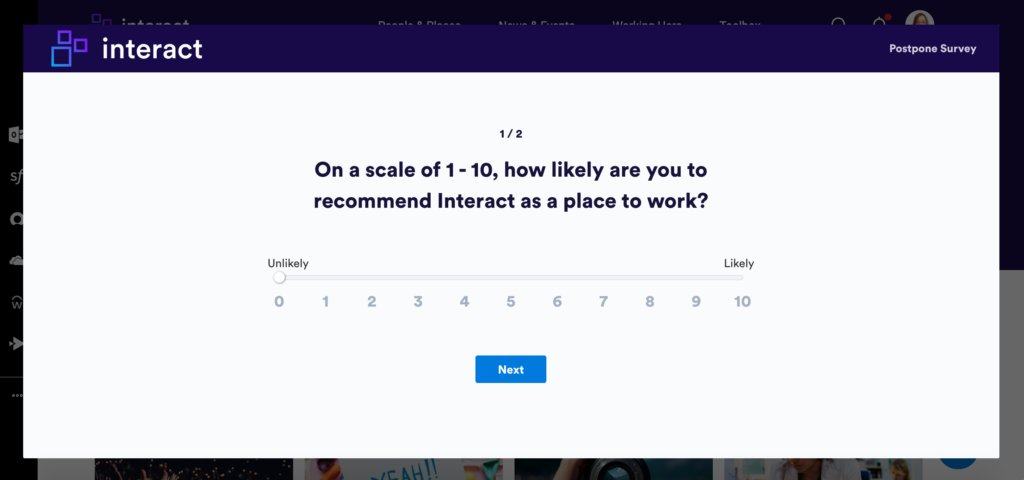
Responses should be anonymous to ensure staff are confident answering truthfully and in an unbiased manner.
Remember that your eNPS is a point in time snapshot; the only way to truly identify trends, monitor progress and make meaningful change, is to conduct it on a regular basis. How often will depend on your culture and circumstances – starting with quarterly is probably a good benchmark, then adjust as needed.
What’s a good eNPS score?
The jury is out on what makes a ‘good’ employee Net Promoter Score.
Arguably, it calls for a consideration of company size, industry – and perhaps most importantly, your previous score. Is it going up, or down?
While the conservative will say anything from -10 to 20 is ‘normal’ or acceptable, we’d argue staying out of the negatives is a no-brainer if you’re looking to keep your organization culture positive. Anything less than -10 is probably where you should start to worry. Above 40 or 50 is a great state of affairs – though of course, no excuse for being complacent!
It’s also crucial to remember that your ‘neutral’ responses don’t get counted.
If you have a number of naturally ‘subdued’ or perhaps understated members of staff – as a true Brit, I’ll put my hand up here – who will rarely (if ever) give a rating of 9 or 10 out of 10, but are positive about their role and consistently giving 8s, they are disregarded or unseen in that score. In this case, it can help to also consider the ‘average’ score provided, as a benchmark.
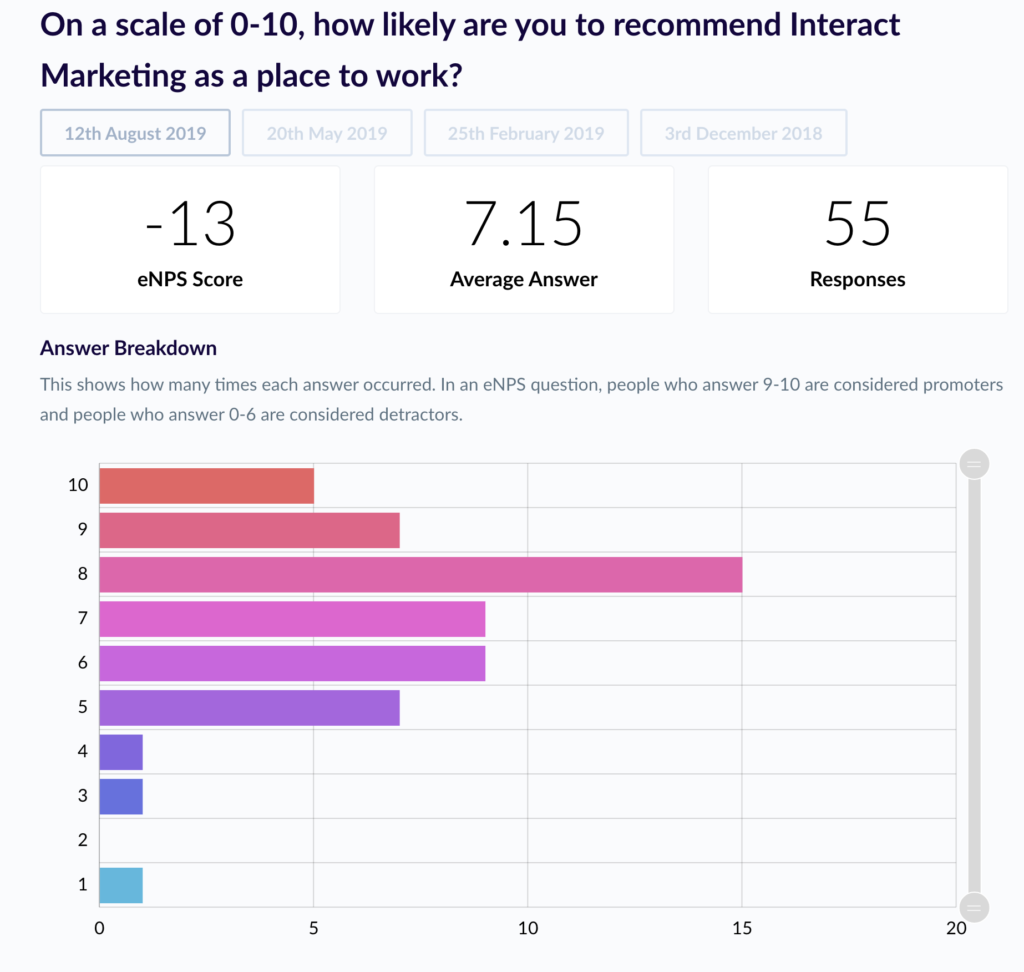
There are many factors feeding into an eNPS and for this reason, experts in the industry warn against benchmarking your score against others in your industry, location, or profession. Instead, looking to your own improvement or trends over time is a more accurate way to benchmark.
It’s important to remember that the score is just a number: the real value comes from delving deeper into the written feedback and understanding why your staff have voted the way they have, and how you can make improvements.
7 useful tips for retaining your employees
Delving deeper: analyzing your eNPS
Your net score is only the tip of the iceberg. To truly understand what’s happening, you’ll need to go a little deeper into the results.
This is where having an effective and dedicated tool can prove invaluable. Being able to break down the responses given can help you identify trends, areas of concern or improvement, and even the most common sentiment or issues in the written responses.
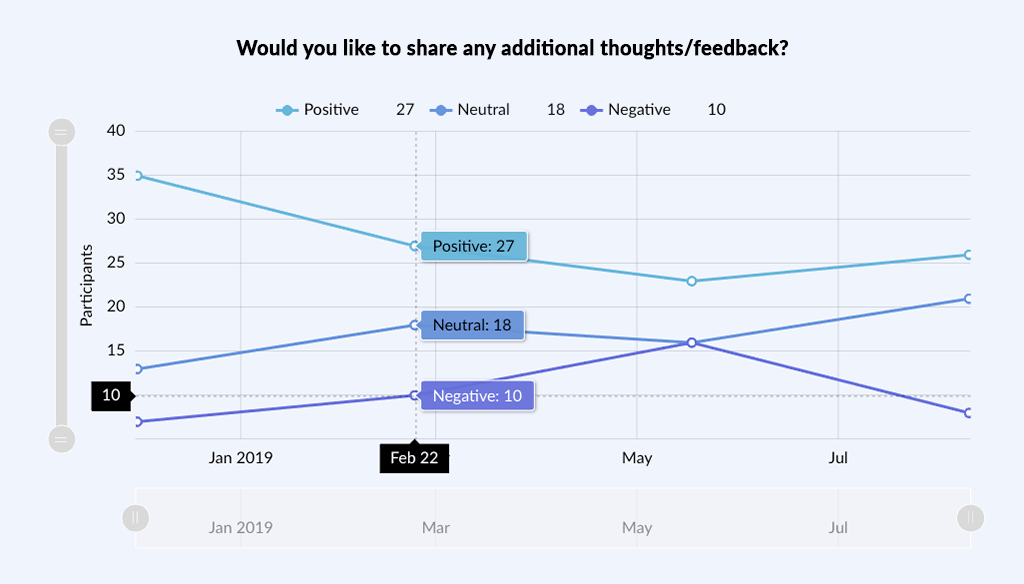
Although your survey should be conducted on an anonymous basis, depending on the size of your organization you may be able to break down response by broad demographics such as department or location.
This can help you identify, for example, that HR has the highest number of low-end detractors, and therefore there may be issues specific to this department that need investigating.
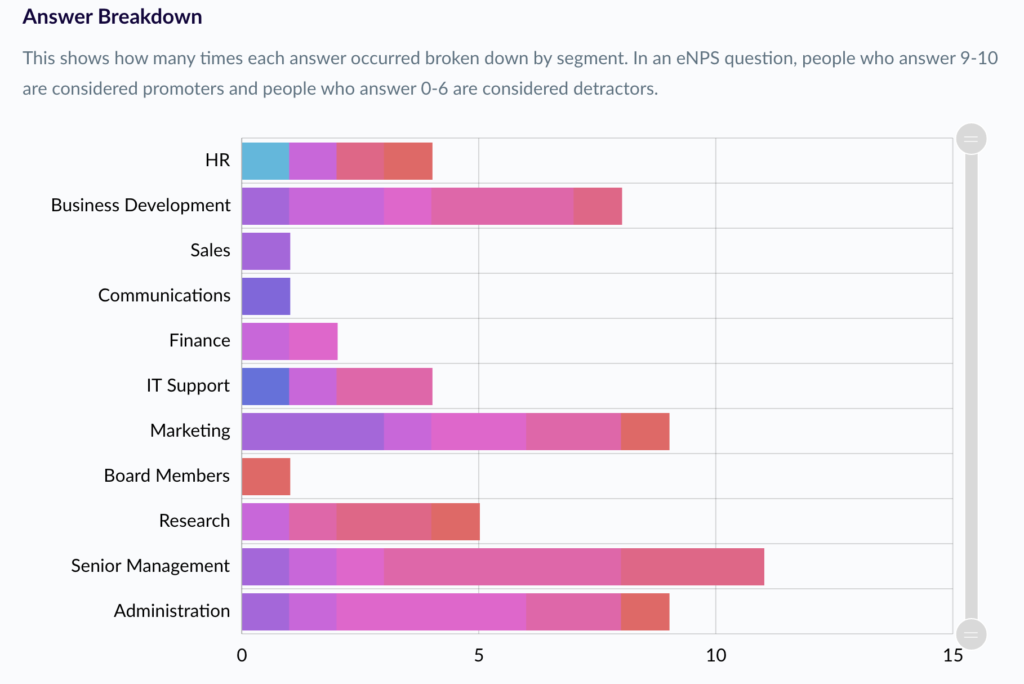
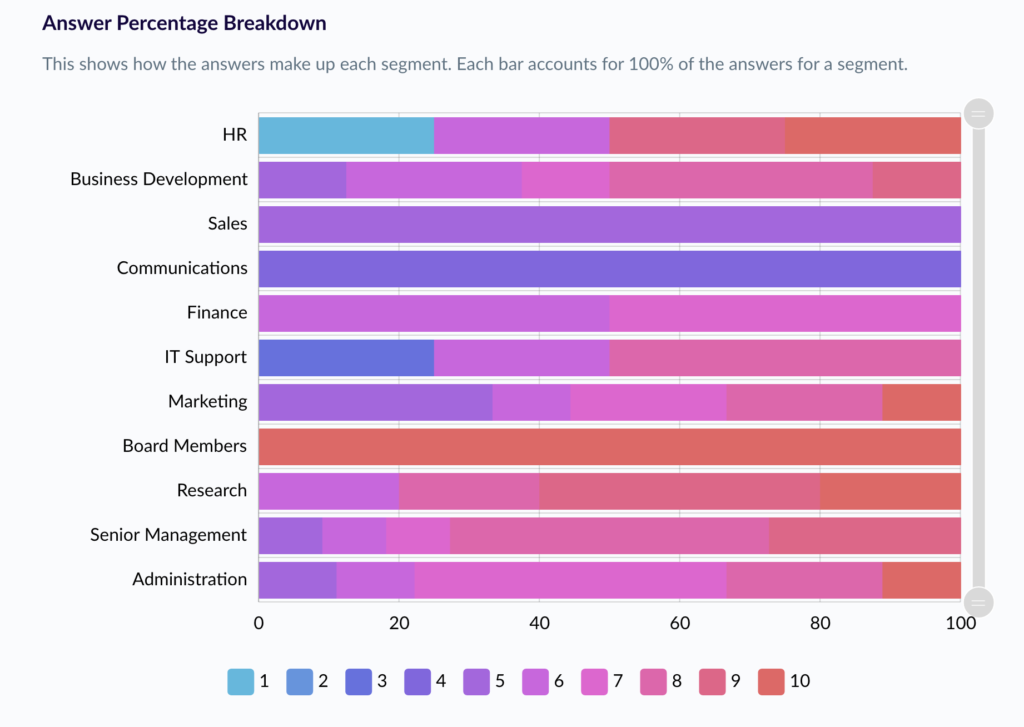
As you conduct your survey periodically, you’ll be able to follow the score shift over time; picking out any seasonality or long-term trends.
Perhaps the greatest value, however, comes from the free-text responses to your second question. The first question gives you the ‘what’; the second, the all-important why.
Intelligent survey software will be able to evaluate responses to identify the most common sentiment, most used phrases, sentiment over time – and, importantly, will also include the raw responses.
Administrators evaluating the data will be able to pick out important feedback and trends, using these to make informed decisions to drive real change.
Remember: even though your ‘neutral’ responders aren’t included in the score, don’t disregard their written feedback. Your long-term objective is to have as many promoters as possible; identify what’s holding them back from being active promoters and ensure you’re addressing their needs, so they’re not at risk of becoming detractors.
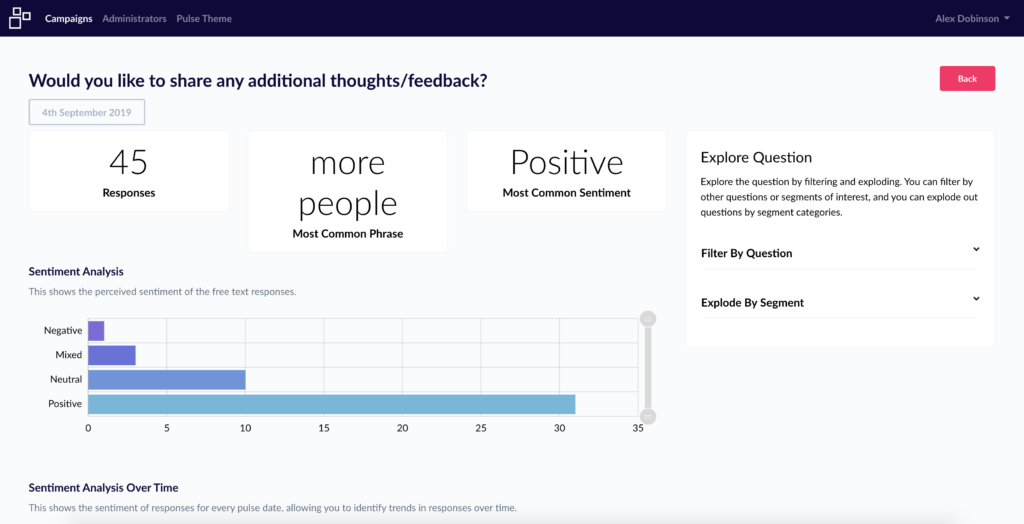
How do I improve my employee Net Promoter Score (eNPS) ?
Getting your score is one thing; acting on those results to drive positive change is another matter entirely. How can you improve things?

There’s no one-size-fits-all silver bullet here. Understandably, your strengths and weaknesses as an organization are going to be unique; identifying areas for improvement will only come from evaluating your responses.
It’s also important to remember that the eNPS is a marathon, not a sprint: change will not happen instantaneously. It’s a case of revisiting and re-evaluating regularly.
However, there are some basic practices that can – and should! – be adopted in order to improve your score.
- Conduct it regularly: this is the only way to gain enough meaningful feedback to identify trends
- Be transparent with the results: this helps your staff feel included and involved in the process
- Acknowledge your shortcomings: if your survey is showing a negative trend or common issue, don’t brush it under the carpet. Acknowledge it, confront it – and change it
- Follow it up: more in-depth, specific, or targeted surveys can go deeper than the eNPS alone to provide the insights needed
- Dedicate time and resource to actioning the results: demonstrate to staff that you’re taking the results seriously and ensure you have allocated resource to evaluating and acting on your eNPS feedback
- Tell staff what you’re doing: don’t just take action, shout about it! When staff can see their feedback has had an effect, morale and company culture improve; you’ll also see more staff participate in future surveys
Communication is key. Your staff are speaking to you: make this a two-way conversation, and engage with them.
Is the employee Net Promoter Score (eNPS) right for measuring engagement in my business?
The eNPS is simple, quick, and tends to see a comparatively higher participation rate than longer-form surveys, which will often fatigue staff. This means it can be conducted more frequently, giving real-time insight into how your staff are feeling and showing any shift or change over time.
The eNPS is only a snapshot. It may tell you roughly where you are, but not how you got there – or how to move forward.
At-a-glance comparisons between one score and the next are easy: if the number goes up or down, you’ve got a good indication of how things are going. With the right software, you can easily see trends, sentiment, break down demographics to flag areas of concern, and more.
However, while its brevity and simplicity are part of its appeal, the eNPS is only a snapshot. It may tell you roughly where you are, but not how you got there – or how to move forward.
Use the eNPS as part of your wider employee engagement strategy, and alongside more in-depth surveys or employee analysis tools. Follow-up surveys that ask more specific, targeted questions can help pinpoint issues. Forums, interviews, focus groups and manager cascades can all support your eNPS survey to give a better picture of how staff are feeling.
Most importantly, don’t forget that asking the question is only the very first step: if you don’t take any action, you risk making things worse by suggesting to staff that their concerns or feedback don’t matter.
An employee Net Promoter Score alone is meaningless. Actions, not words, are what matter.

